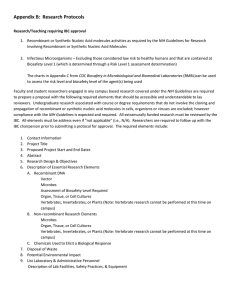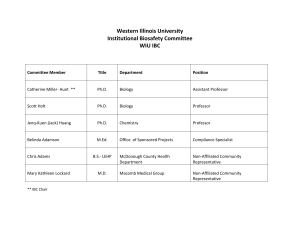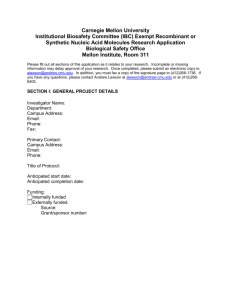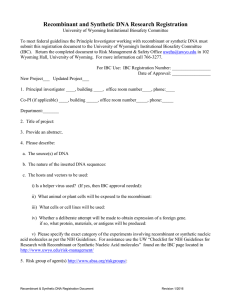BIOSAFETY APPLICATION FORM
advertisement
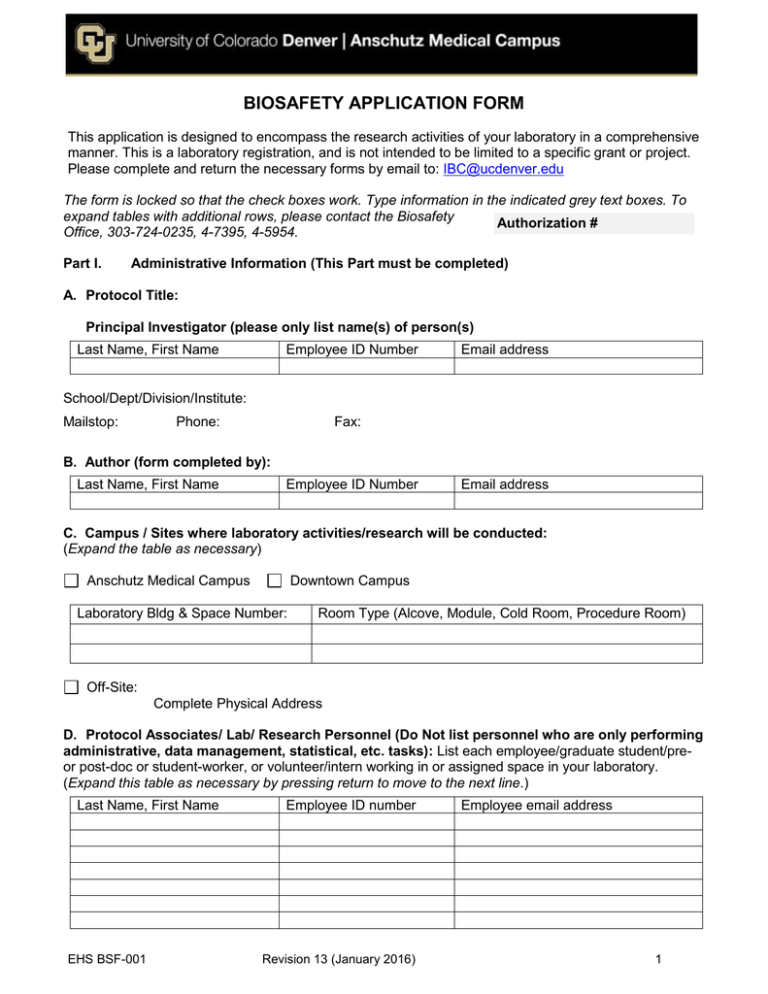
BIOSAFETY APPLICATION FORM This application is designed to encompass the research activities of your laboratory in a comprehensive manner. This is a laboratory registration, and is not intended to be limited to a specific grant or project. Please complete and return the necessary forms by email to: IBC@ucdenver.edu The form is locked so that the check boxes work. Type information in the indicated grey text boxes. To expand tables with additional rows, please contact the Biosafety Authorization # Office, 303-724-0235, 4-7395, 4-5954. Part I. Administrative Information (This Part must be completed) A. Protocol Title: Principal Investigator (please only list name(s) of person(s) Last Name, First Name Employee ID Number Email address School/Dept/Division/Institute: Mailstop: Phone: Fax: B. Author (form completed by): Last Name, First Name Employee ID Number Email address C. Campus / Sites where laboratory activities/research will be conducted: (Expand the table as necessary) Anschutz Medical Campus Downtown Campus Laboratory Bldg & Space Number: Room Type (Alcove, Module, Cold Room, Procedure Room) Off-Site: Complete Physical Address D. Protocol Associates/ Lab/ Research Personnel (Do Not list personnel who are only performing administrative, data management, statistical, etc. tasks): List each employee/graduate student/preor post-doc or student-worker, or volunteer/intern working in or assigned space in your laboratory. (Expand this table as necessary by pressing return to move to the next line.) Last Name, First Name EHS BSF-001 Employee ID number Revision 13 (January 2016) Employee email address 1 I acknowledge all requirements and restrictions of the most current NIH Guidelines for the Biosafety Level approved by the IBC. As the Principal Investigator I accept responsibility for the safe conduct of the experiments conducted at the Biosafety Level approved by the IBC. I understand that it is my responsibility to assure that all personnel working in my laboratory with any hazardous materials are fully informed about their specific dangers, proper actions for safe use and disposal, steps to take in case of accidents, and are provided with all necessary safety equipment and instructions in its use. I understand that it is my responsibility to assure that all personnel working in my laboratory with any of these hazards are fully informed about their responsibility to report any spills, accidents, exposures, etc. to the Biosafety Office/Dept. of Environmental Health & Safety and University Risk Management/Workers Compensation Program as appropriate. Date Signature of Principal Investigator PLEASE FILL OUT THE REST OF THIS FORM BY ANSWERING ALL SECTIONS APPLICABLE TO YOUR RESEARCH ENDEAVORS. The form is locked so that the check boxes work. Type information in the indicated grey text boxes. To expand tables with additional rows, please contact the Biosafety Office, 303-724-0235, 4-7395, 4-5954. EHS BSF-001 Revision 13 (January 2016) 2 Part II. Types of Experiments (This Part must be completed) A. We will use the following research materials: complete all Parts for “Yes” Experiments with Biological Materials or Infectious Agents Part of rDNA research: 1. Recombinant or synthetic nucleic acid molecules or organisms (includes plasmids, viral vectors) If Yes, complete Part III of this form. Yes No Experiments with Biological Materials or Infectious Agents NOT Part of rDNA research: 2. Human blood, body fluids (saliva, mucus, feces, urine, etc.), tissues, organs Yes If Yes, complete Part IV-A of this form. No 3. Human Primary or immortalized cell cultures or cell lines If Yes, complete Part IV-B of this form. Yes No 4. Non-Human Primate – tissue, cells, bodily fluids/excreta If Yes, complete Part V of this form Yes No 5. Biological or Infectious Agents If Yes, complete Part VI of this form. Yes No Yes No 7. Animal specimens, tissues or organs If Yes, complete Part VII-B of this form. Yes No 8. Animal Primary or immortalized cell cultures or cell lines If Yes, complete Part VII-C of this form. Yes No Experiments with Whole Animals, Transgenic Animals, Tissues, or Cells 6. Whole Animals or Transgenic Animals (vertebrate or invertebrate animals) If Yes, complete Part VII-A of this form and Appendix T (submit with this Form). Experiments Involving Select Agent Pathogens and Toxins (includes Exempt Quantities) 9. Select Agent Pathogens: (http://www.selectagents.gov/index.html) Yes If Yes, contact the University Responsible Official and Institutional Biosafety Officer for further instructions and to complete all necessary documents for IBC review and approval. 10. Select Agent Toxins: (http://www.selectagents.gov/index.html) If Yes, complete SA Toxins Form, Appendix A and submit with this form. Experiments Involving Plants 11. Recombinant or synthetic nucleic acids, infectious agents or microorganisms affecting plants in conjunction with plants or plant materials. If Yes, complete Part III and Appendix P, and submit with this form. Field Research 12. Field studies. If Yes, contact the Biosafety Officer at 724-0235 or via email at ibc@ucdenver.edu Yes No Yes No Yes No The following Parts of this Application MUST be completed regardless of how the questions above were answered: Part II. B. Part VIII. Part IX. Part X. Part XI. Research Narrative/Goals of Study Risk Assessment and Containment Dual Use Research Shipping/Receiving Biological Materials Required Trainings EHS BSF-001 Revision 13 (January 2016) No 3 B. Research Narrative/Goals of Study (This Section must be completed) Please describe the goals of your research, focusing on how biological materials, model organisms, pathogens, rDNA, toxins, hazardous chemicals and/or radioactive materials will be used. Explain all boxes checked “yes” in Part II. A. Narrative: Part III. Use of Recombinant DNA (rDNA) Use of rDNA materials is regulated by the NIH Office of Biotechnology Activities. The NIH defines recombinant and synthetic nucleic acid molecules as: (i) molecules that a) are constructed by joining nucleic acid molecules and b) can replicate in a living cell (i.e. recombinant nucleic acids); (ii) nucleic acid molecules that are chemically or by other means synthesized or amplified, including those that are chemically or otherwise modified but can base pair with naturally occurring nucleic acid molecules (i.e. synthetic nucleic acids);OR (iii) molecules that result from the replication of those described in (i) or (ii) above. A. Recombinant DNA Research Narrative Specifically describe the manner in which you are planning on using recombinant and/or synthetic nucleic acids in sufficient detail to allow the comprehensive review and approval of your research involving recombinant DNA or organisms containing recombinant nucleic acids. (Please do not paste Grant Abstracts or Project Narratives into this section) B. Recombinant DNA Research, NIH Guidelines 1. Use of nonpathogenic prokaryotic or lower eukaryotic organism(s) Does your research involve the use of nonpathogenic prokaryotic or lower eukaryotic organism(s) as part of a host-vector system (ex: E. coli K12 derivative, S. cerevisiae, B. subtilis)? Yes No If Yes, please list the strain(s) of nonpathogenic prokaryotic or lower eukaryotic organism(s) in use. If multiple organisms are used, you may attach a document or spreadsheet with this information using the paperclip icon in the upper right hand side of this box. 2. Host of Recombinant or Synthetic Nucleic Acid Materials Natural or synthetic recombinant DNA or RNA molecules will be used in the following: NA a. Bacteria, including Rickettsia – Complete Table Pathogen Name (Genus, Species) NA Is Vol. >10L Route of Exposure for a Single (inhalation, Material Risk Vessel? contact, ingestion, is viable Human Animal Plant Group Y/N vector borne) (Y/N) Do any Bacteria listed in the table above express antibiotic resistance? If Yes, list Bacteria and its associated antibiotic resistance: EHS BSF-001 Revision 13 (January 2016) Yes No 4 b. Virus – Complete Table NA Pathogen Name (Genus, Species) Is Vol. >10L Route of Exposure for a Single (inhalation, Material Risk Vessel? contact, ingestion, is viable Human Animal Plant Group Y/N vector borne) (Y/N) c. Yeast / Fungi – Complete Table Name (Genus, Species) Is Vol. >10L Route of Exposure for a Single (inhalation, Material Risk Vessel? contact, ingestion, is viable Human Animal Plant Group Y/N vector borne) (Y/N) d. Parasites – Complete Table Name (Genus, Species) NA Pathogen NA Pathogen Is Vol. >10L Route of Exposure for a Single (inhalation, Material Risk Vessel? contact, ingestion, is viable Human Animal Plant Group Y/N vector borne) (Y/N) e. Primary culture or cell lines - Complete Table Cell Line NA Source: Used with *Embryonic Replicate Used with Viral Origin: (specify if stem Risk Virus Plasmids Vectors Human, cell), *Placental, Group: (Y/N) (Y/N) (Y/N) Animal, Plant *Fetal, Adult 1, 2, 3 *If Embryonic Stem Cell, are they listed on the NIH Stem Cell Registry? Yes No *For Embryonic Stem Cell, Placental or Fetal, please list the specific source of each cell line listed above. You must include Name, address, etc. f. Immortalized culture or cell lines - Complete Table Cell Line NA Source: Used with *Embryonic Replicate Used with Viral Origin: (specify if stem Risk Virus Plasmids Vectors Human, cell), *Placental, Group: (Y/N) (Y/N) (Y/N) Animal, Plant *Fetal, Adult 1, 2, 3 *If Embryonic Stem Cell, are they listed on the NIH Stem Cell Registry? Yes No *For Embryonic Stem Cell, Placental or Fetal, please list the specific source of each cell line listed above. You must include Name, address, etc. EHS BSF-001 Revision 13 (January 2016) 5 g. Whole animals (vertebrate or invertebrate; transgenic or non-transgenic) The material is Viable Non-viable Complete Appendix T, and submit with this form Yes NA h. Plants or plant pathogens or pests (transgenic or non-transgenic) Complete Appendix P, and submit with this form. Yes NA C. Nature of Vectors 1. My vector(s) is/are plasmid-based. Describe the plasmids and inserts or the nature of synthetic nucleic acid, using plasmid maps if available. Provide source of plasmid material: (e.g. purchased from Vendor X, obtained from Dr. Y, etc.) 2. My vector(s) is/are viral in origin. Complete the following section for each viral vector in use. If human or amphotropic vectors will be used, please provide a detailed description including species-specificity, as applicable. Strain, vector backbone: Wild type deletions: (Name of deleted genes) Replication status: Envelope packaging system(s): Helper Virus required (Y/N, if Yes, specify) Source of vector (made in lab X, purchased from Company Y, gift from Dr. Z) Adenovirus Adeno associated Virus Alphavirus (e.g. SFV, SIN) Herpesvirus Poxvirus (e.g. Vaccinia) Murine Retrovirus Human Lentivirus (HIV) Other: 3. Provide the following information concerning the nature of the insert(s): a. What is the source of the DNA insert? Please include genus and species names of the organism(s) from which the DNA is derived. b. Please provide the full names and abbreviations of the gene(s), promoter(s) and/or transposable elements to be studied, and a brief description of the biological function of the nucleic acid sequence. (Indicate if this is cDNA, genomic DNA, or specific genes). EHS BSF-001 Revision 13 (January 2016) 6 c. If the DNA is from a eukaryotic virus and it is to be introduced into a eukaryotic host, provide the percentage of the viral genome to be cloned. % d. If this is a mutated gene, please describe. e. What do you know of the oncogenic potential of the genes of interest? If this is a known or suspected oncogene, please describe sufficiently for IBC review. f. What do you know of the potential insertional mutagenesis of the vectors or the genes of interest? 4. Please provide details of the target/recipient cells or systems of the vector-DNA combination. What is the target cell/system, animal or plant host(s)? Please provide detailed information about the host(s) (e.g., E. coli K-12 system, Saccharomyces, insect cells, plant cells, live animals, whole plants, etc.) 5. List the specific foreign nucleic acids/proteins that will be expressed. Identify any known or potential hazards associated with the expression of the foreign nucleic acids/proteins you will be working with. D. Manipulations 1. Will you conduct Flow Cytometry or Cell Sorting or Laser Microdissection of any cells containing recombinant DNA? NA List location for each. Flow Cytometry, Location: Cell Sorting, Location: Laser Microdissection : 2. Will you use any of the following materials in combination with recombinant DNA? a. Radioisotopes Isotope(s): NA Authorization Number: b. Select Agent Pathogens - contact the University Responsible Official and Institutional Biosafety Officer for further instructions and to complete all necessary documents for IBC review and approval. c. Select Agent Toxins (including exempt quantities) - complete SA Toxins Form, Appendix A and submit with this form. E. Source and Nature of Introduced Nucleic Acid or Expressed Protein My research involves: Please select any that apply to your construct(s) 1. 2. 3. Extrachromosomal elements of a gram positive organism Your research falls under NIH Guidelines Appendix C-VI The inserted gene encodes for the biosynthesis of toxin molecules lethal for vertebrates at an LD50 of less than 100 nanograms per kilogram body weight (e.g., microbial toxins such as the botulinum toxins, tetanus toxin, diphtheria toxin, and Shigella dysenteriae neurotoxin). Your research falls under NIH Guidelines Section III-B-1 The inserted gene encodes for a potential or known allergen Your research falls under OSHA Act of 1970, General Duty Clause 5 (a) 1, 2 EHS BSF-001 Revision 13 (January 2016) 7 4. 5. The inserted gene confers a drug resistance trait to microorganisms that are not known to acquire the trait naturally, if such acquisition could compromise the use of the drug to control disease in humans, veterinary medicine or agriculture. Your research falls under NIH Guidelines Section III-A-1-a If you check this box – explain the “drug resistance trait” N/A F. Source and Nature of Introduced Nucleic Acid or Expressed Proteins My research involves: Please select any that apply to your experiment(s). 1. 2. 3. 4. 5. 6. 7. 8. 9. 10. OPTION A: Synthetic nucleic acids that can neither replicate nor generate nucleic acids that can replicate in any living cell (e.g., oligonucleotides or synthetic nucleic acids that do not contain an origin of replication or contain elements known to interact with either DNA or RNA) If OPTION A, B & C are all three checked, then your research falls under NIH Guidelines Section III-F-1 OPTION B: Synthetic acids that are not designed to integrate in to DNA If OPTION A, B & C are all three checked, then your research falls under NIH Guidelines Section III-F-1 OPTION C: Synthetic acids that do not produce a toxin that is lethal for vertebrates at an LD50 of less than 100ng/kg body weight If OPTION A, B & C are all three checked, then your research falls under NIH Guidelines Section III-F-1 Recombinant or synthetic acids that are not in organisms, cells, or viruses and that have not been modified or manipulated (e.g., encapsulated into synthetic or natural vehicles) to render them capable of penetrating cellular membranes Your research falls under NIH Guidelines Section III-F-2 Recombinant or synthetic acids that consist solely of the exact recombinant or synthetic nucleic acid sequence from a single source that exists contemporaneously in nature Your research falls under NIH Guidelines Section III-F-3 Recombinant or synthetic acids that consist entirely of nucleic acids from a prokaryotic host, including its indigenous plasmids or viruses when propagated only in that host (or a closely related strain of the same species), or when transferred to another host by well-established physiological means Your research falls under NIH Guidelines Section III-F-4 Recombinant or synthetic acids that consist entirely of nucleic acids from a eukaryotic host including its chloroplasts, mitochondria, or plasmids (but excluding viruses) when propagated only in that host (or a closely related strain of the same species) Your research falls under NIH Guidelines Section III-F-5 Recombinant or synthetic acids that consist entirely of DNA segments from different species that exchange DNA by known physiological processes, though one or more of the segments may be a synthetic equivalent (See Appendices A-I through A-VI of the NIH Guidelines for a list of natural exchangers) Your research falls under NIH Guidelines Section III-F-6 Genomic DNA molecules that have acquired a transposable element, provided the transposable element does not contain any recombinant and/or synthetic DNA Your research falls under NIH Guidelines Section III-F-7 N/A G. Risk Group 2 or 3 Agents as Host-Vector Systems Does your research involve using Risk Group 2 or Risk Group 3 or Restricted Agents as HostVector Systems? Please select any that apply to your experiment(s). 1. 2. 3. Yes, there will be introduction of recombinant or synthetic nucleic acids into Risk Group 2 agent(s). Your research falls under NIH Guidelines Section III-D-1-a. Yes, there will be introduction of recombinant or synthetic nucleic acids into Risk Group 3 agent(s). Your research falls under NIH Guidelines Section III-D-1-b. Yes, there will be introduction of recombinant or synthetic nucleic acids into Restricted Agents(s) EHS BSF-001 Revision 13 (January 2016) 8 4. Your research falls under NIH Guidelines Section III-D-1-d. Your work may require an USDA/APHIS permit and fall under NIH Guidelines V-G and/or V-M. No H. Risk Group 2 or 3 DNA into Non Pathogenic Host-Vector Systems Does your research involve the transfer of genetic material from Risk Group 2, Risk Group 3, or Restricted agents into a nonpathogenic prokaryotic or lower eukaryotic host-vector system? Please select any that apply to your experiment(s). 1. 2. 3. Yes, genetic material from RG2 or RG3 will be transferred. Your research falls under NIH Guidelines Section III-D-2-a. Yes, genetic material from a Restricted Agent will be transferred. Your research falls under NIH Guidelines Section III-D-2-b. Your work may require a USDA permit and fall under NIH Guidelines V-G and/or V-L. No I. Drug Resistance Does your research involve the deliberate transfer of a drug resistance trait to microorganism(s) not known to naturally possess this trait and therefore that could compromise the use of the drug to control disease in humans, veterinary medicine or agriculture? Yes (Your research falls under the NIH Guidelines Section III-A-1-a) No If Yes, please name the drug for which resistance is being introduced. J. Cloning of Toxin Molecules Does your research involve the cloning of toxin molecules? Yes (Cloning of Toxins with an LD50 <100ng/kg body wt. falls under NIH Guidelines Section III-B-1) No If yes, please list (subunit, chimeras, holotoxin, etc.) and describe its purpose and LD50 Part IV. Human Biological Materials, Specimens, Culture Materials NOT part of rDNA Research Receiving and/or working with human specimens and/or human cell lines requires enrollment in the Occupational Health Program. Contact 303-724-9145 A. Human Blood, Body Fluids, Tissues, or Organs 1. Will you collect, work with or bank human blood, body fluids, tissues, or organs? Yes No If Yes, complete the following section - please check or list all that apply. Also, consult with the UCD COMIRB regarding human subjects’ research application requirements. 2. Specimens collected or manipulated: check all that apply Blood Serum Feces Urine Semen Spinal fluid Tissues/Organs Other: 3. Types of manipulation(s): check all that apply Centrifugation Frozen Sections Pipetting Dissection Blending/mixing Sonication Fixed/preserved in: Flow Cytometry, Location: EHS BSF-001 Revision 13 (January 2016) 9 Cell Sorting, Location: Other 4. Will the specimens be labeled with radioisotopes? If yes, Isotope(s): Yes No Authorization Number: B. Human Primary or Immortalized Cells in Culture NOT part of rDNA Research a. Primary & Immortalized culture or cell lines - Complete Table NA Source: 1 Embryonic List List (specify if stem Biological isotope(s) Risk Primary or cell), 3Placental; 3Toxin used used in Group: Cell Line Immortalized Fetal, Adult; NA in culture; NA culture; NA 1, 2, 3 1 If Human Embryonic Stem Cell, are they listed on the NIH Stem Cell Registry? Yes No 2 *If Placental Cell, please list the specific source of each cell line listed above. You must include Name, address, etc. 3 If your toxin appears on the Select Agent List, you must complete and submit a Select Agent Toxin Application- Appendix A. Part V. Non-Human Primate (NHP) - Tissue, Cells, Bodily Fluids NOT part of rDNA Research Receiving and/or working with unfixed NHP materials requires enrollment in the Occupational Health Program. Contact 303-724-9145 1. Are you working with Non-Human Primate tissue, cells, or bodily fluids? If Yes, please complete the following Table(s) for each “Genus” / “Species”: Genus Species Source Please check all that apply for NHP listed in Table above: Tissue, specify The material is Viable Cells The material is Viable Bodily Fluid(s), specify The material is Viable Genus Species No Is Permit Required? Yes No Non-viable Non-viable Non-viable Source Please check all that apply for NHP listed in Table above: Tissue, specify The material is Viable Cells The material is Viable Bodily Fluid(s), specify The material is Viable Yes Is Permit Required? Yes No Non-viable Non-viable Non-viable 2. List Approved and/or Pending Permits (APHIS, CITES, Country of Origin Export permit, etc.) and specify material. EHS BSF-001 Revision 13 (January 2016) 10 Part VI. Experiments with Other Biological or Infectious Agents NOT part of rDNA Research Complete this section if you use microorganisms with the potential to infect animals, plants or humans, not otherwise addressed above for Part III. Use of Recombinant DNA (rDNA). Receiving and/or working with Infectious Agents requires enrollment in the Occupational Health Program. Contact 303-724-9145 1. Does your research involve the use of any of the following microorganisms not otherwise covered in Part III above? Yes No If No, continue to Part VIII. If Yes, complete this section for each of the microorganisms to be used in research. Please check all that apply: Bacteria, including Rickettsia Virus Yeast/Fungi Parasites List agent(s) by Genus, species (expand this table as necessary). Include all viruses, bacteria, yeast, fungi, rickettsia or parasites. To determine the correct Risk Group, refer to NIH Guidelines, Appendix B, the CDC BMBL Agent Summary Statements, or discuss with the Biosafety Office. a. Bacteria, including Rickettsia – Complete Table Pathogen Name (Genus, Species) NA Route of Exposure (inhalation, contact, Material Risk ingestion, vector is viable Human Animal Plant Group Volume borne) (Y/N) Do any Bacteria listed in the table above express antibiotic resistance? If Yes, list Bacteria and its associated antibiotic resistance: b. Virus – Complete Table Yes No NA Pathogen Name (Genus, Species) Route of Exposure (inhalation, contact, Material Risk ingestion, vector is viable Human Animal Plant Group Volume borne) (Y/N) c. Yeast / Fungi – Complete Table Name (Genus, Species) Route of Exposure (inhalation, contact, Material Risk ingestion, vector is viable Human Animal Plant Group Volume borne) (Y/N) d. Parasites – Complete Table Name (Genus, Species) EHS BSF-001 NA Pathogen NA Pathogen Route of Exposure Risk (inhalation, contact, Material Group ingestion, vector is viable Human Animal Plant 1, 2, 3 Volume borne) (Y/N) Revision 13 (January 2016) 11 2. For any agent listed above that is a Pathogen to humans or animals, is there a vaccine available? Yes No If Yes, please list the Pathogen and the vaccine available. 3. Are animal or human pathogens to be used in animals? If Yes, please list each pathogen and IACUC information: Pathogen IACUC Protocol # Yes IACUC Approval Date No Vivarium Facility 4. Will any Agent listed in the above Tables be capable of transducing or potentially infectious to plants? Yes If Yes, complete and submit Appendix P, with this form. No 5. Does any Agent listed in the Tables above require a CDC or USDA-APHIS or other permit? Yes No If Yes, please list the Agent and specify the permit(s). A copy of each Permit must be forwarded to the Biosafety Office. 6. Will any Agent listed in the Tables above be labeled with a radioisotope? Yes No If Yes, please list each Agent and Radiation Safety information: Agent Isotope(s) Authorization # Approval Date 7. Complete the following section for each Agent listed in the Tables above to be used in the lab. a. Location(s), building and laboratory rooms, where agent(s) will be used/handled Biological Agent: Laboratory Bldg & Room Number: Part VII. Experiments with Whole Animals, Transgenic Animals, Blood, Bodily Fluids, Tissues, Specimens, Cells A. Whole Animals or Transgenic Animals (in-vitro or in-vivo) 1. Will you work with Whole animals and/or Transgenic animals? If Yes, Complete Appendix T, and submit with this form Yes No B. Animal Blood, Bodily Fluids, or Tissues EHS BSF-001 Revision 13 (January 2016) 12 1. Will your experiments use any of the following: Animal blood; Species Body fluids, Species Tissues; Species 2. Will the specimens be labeled with radioisotopes? If yes, Isotope(s): Authorization Number: Yes No C. Animal Primary or Immortalized Cells in Culture a. Primary & Immortalized culture or cell lines - Complete Table Cell Line 1 NA Risk Primary or List Biological 1Toxin List isotope(s) Group: Immortalized used in culture; NA used in culture; NA 1, 2, 3 If your toxin appears on the Select Agent List, you must complete and submit a Select Agent Toxin Application- Appendix A. Part VIII. Risk Assessment and Containment (This Part must be completed) 1. Is a Biological Safety Cabinet (tissue culture hood) available? Yes No Biosafety Cabinet Information (expand this table as necessary) BSC # Manufacturer Model Class Serial Number Type Certification Date Bldg./Room # 2. Does this project constitute any other potential risk or hazards to human health or the environment which are not described above? Yes No If yes, explain. Use additional pages as necessary. Part IX. Dual Use Research (This Part must be completed) Dual Use Research, as defined by the federal government, is under the oversight of the NIH, Office of Biotechnology Activities (OBA), and National Science Advisory Board for Biosecurity (NSABB). Are you are using one or more of the following agents or toxins (any quantity)? Yes No (this Part is now complete) Agents and toxins a) Avian influenza virus (highly pathogenic) b) Bacillus anthracis c) Botulinum neurotoxins d) Burkholderia mallei e) Burkholderia pseudomallei f) Ebola virus g) Foot-and-mouth disease virus h) Francisella tularensis i) j) k) l) m) n) o) Marburg virus Reconstructed 1918 Influenza virus Rinderpest virus Toxin-producing strains of Clostridium botulinum Variola major virus Variola minor virus Yersinia pestis If YES, check any categories of experiments below that apply to your research experiments or projects: Enhances the harmful consequences of the agent or toxin EHS BSF-001 Revision 13 (January 2016) 13 Disrupts immunity or the effectiveness of an immunization against the agent or toxin without clinical and/or agricultural justification Confers to the agent or toxin resistance to clinically and/or agriculturally useful prophylactic or therapeutic interventions against that agent or toxin or facilitates their ability to evade detection methodologies Increases the stability, transmissibility, or the ability to disseminate the agent or toxin Alters the host range or tropism of the agent or toxin Enhances the susceptibility of a host population to the agent or toxin Generates or reconstitutes an eradicated or extinct agent or toxin listed above Check here if none of the above applies Part X. Shipping/Receiving Step #1. The Office of Regulatory Compliance requires that all materials being shipped/Exported outside of the United States be reviewed to determine what restrictions may apply. Will you be shipping/exporting any biological materials? If Yes, please go to the Export Control web site and complete the Shipping Worksheet Yes No http://www.ucdenver.edu/academics/research/AboutUs/regcomp/exportcontrol/Pages/ExportControl.aspx Step #2. Please contact EHS Biosafety Program at Biosafety.Program@ucdenver.edu for assistance in Shipping and/or Receiving biological materials. You must have completed the CU: Shipping of Biological Materials (C20003) course within the past 2 years to meet the regulatory requirements for shipping biological materials. Part XI. Required Trainings All of the lab personnel listed in this Biosafety Application form have required trainings to complete. This Application cannot be approved until all required trainings have been completed by lab personnel All trainings are available on the SkillSoft web site: http://www.ucdenver.edu/academics/research/AboutUs/health-safety/training/Pages/skillsoft.aspx Required Courses CU: Blood Borne Pathogens/Exposure Control Training CU: Lab Safety Training CU: Chemical Waste Management CU: NIH Guidelines for rDNA (if this Protocol uses rDNA) CU: Regulated Medical Waste Management CU: Shipping of Biological Materials (if you are shipping/receiving biological materials) Radiation Safety (if you are using Radioactive Materials) EHS BSF-001 Revision 13 (January 2016) Course # U00069 U00050 U00068 U00132 U00089 Frequency Annually Within 45 days of Hire Annually Once Once C20003 Every 2 Years See EHS web site 14 This space is for IBC and Biosafety Office Use Authorization #: Approval Date: New Expiration Date: Amendment Renewal Biosafety Office Pre-review: Date Personnel registered in EHS-A Personnel training verified in EHS-A HepB Vaccine Status Needs To Be Reviewed by OH Lab Personnel and Training Status Letter to PI Medical Surveillance / OH Review Needed for (list agent(s): Pre-review Status: No rDNA Research Exempt rDNA Research NIH Sections: Requires IBC Review N/A Select Agents and Toxins: Infectious Agents: Human Tissue, Cells, Fluids Biosafety Level: BSL-1 Animal Biosafety Level: Non-Human Primate Tissue, Cells, Fluids BSL-2 ABSL-1 Animal Tissue, Cells, Fluids BSL-3 ABSL-2 ABSL-3 Animal Species Protocol Review Sheet Routed to IBC No Review Comments Pre-Review Comments: Training Required: Full Committee Review: Review Date Approval Date Expiry Date Authorization Memo Date NIH Sections: N/A Approved Modifications Required Deferred Denied Medical Surveillance / OH Review Needed Biosafety Level: BSL-1 Animal Biosafety Level: BSL-2 ABSL-1 BSL-3 ABSL-2 ABSL-3 Animal Species EHS BSF-001 Revision 13 (January 2016) 15 Information for IBC Minutes Agent characteristics (e.g. virulence, pathogenicity, environmental stability) Types of manipulations planned Source(s) of the nucleic sequences (e.g., species) Nature of the nucleic acid sequences (e.g., structural gene, oncogene) Host(s) and vector(s) to be used Whether and attempt will be made to obtain expression of a foreign gene, and if so, the protein that will be produced EHS BSF-001 Comments Part II, III (1, 2 & 3) & IV List of what materials handled: human, animal, cell lines, toxins, transgenic animals, microorganisms/RG, pathogens in animals Part IV-A-1 & Part III-C-6: manipulations PART III-C-3-a Part III-C-3-b Part III-C-4 Part III-C-5 Revision 13 (January 2016) 16
